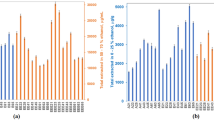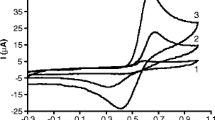Abstract
Propolis (bee glue) is a sticky dark-colored material that honeybees collected from parts of plants, buds and exudates, and used as construction and defense material in the hive. This resinous substance is a rich source of phenolic compounds, and its chemical composition is strongly influenced by its phytogeographic origin. This research outlines the evaluation of the redox profile and the quantification of the total antioxidant capacity in Portuguese propolis from different origins and potential floral sources Populus x canadensis Moench and Cistus ladanifer L through cyclic voltammetry and differential pulse voltammetry. Although several oxidation processes were showed by propolis samples, which were dependent of the resin origin, common oxidation potentials within the majority of samples of a region were detected, suggesting an analogous chemical composition in respect of electroactive species. Based on the quantification of the total electroactive antioxidant power, it was found that propolis with higher antioxidant activity was from coast center, followed by north ~ Azores Archipelago > central interior > Madeira Island > south.


Similar content being viewed by others
References
Rice-Evans CA, Parker L (1998) Flavonoids in health and disease. Marcell Dekker, New York
Snapos G, Wrolstad R (1992) Phenolics of apple, pear, and white grape juices and their changes with processing and storage. A review. J Agric Food Chem 40:1478–1487
Segura M, Novak I, Jakobek L (2011) Determination of polyphenols content and antioxidant activity of some red wines by differential pulse voltammetry, HPLC and spectrophotometric methods. Food Chem 124:1208–1216
Gómez-Caravac AM, Gómez-Romero M, Arráez-Román D, Segura-Carretero A, Fernández-Gutiérrez A (2006) Advances in the analysis of phenolic compounds in products derived from bees. J Pharmaceut Biomed Anal 46:1220–1234
Bankova VS, De Castro SL, Marcucci MC (2000) Propolis: recent advances in chemistry and plant origin. Apidologie 3:13–15
Salatino A, Fernandes-Silva CC, Righi AA, Salatino MFL (2011) Propolis research and the chemistry of plant products. Nat Prod Rep 28:925–936
Falcão SI, Vale N, Gomes P, Domingues MRM, Freire C, Cardoso SM, Vilas-Boas M (2013) Phenolic profiling of Portuguese propolis by LC-MS spectrometry: uncommon propolis rich with flavonoid glycosides. Phytochem Anal 24(4):309–318
Sforcin JM, Bankova V (2011) Propolis: is there a potential for the development of new drugs? J Ethnopharmacol 133:253–260
Kumazawa S, Hamasaka T, Nakayawa T (2004) Antioxidant activity of propolis of various geographic origins. Food Chem 84:329–339
Jasprica I, Bojic M, Mornar A, Basic E, Bucan K, Medic-Saric M (2007) Evaluation of antioxidative activity of croatian propolis samples using DPPH and ABTS + stable free radical assays. Molecules 12:1006–1021
Blasco AJ, Crevillén AG, González MC, Escarpa A (2007) Direct electrochemical sensing and detection of natural antioxidants and antioxidant capacity in vitro systems. Electroanal. 22:2275–2286
Huang D, Ou B, Prior RL (2005) The chemistry behind antioxidant capacity assays. J Agric Food Chem 53:1841–1856
Mannino S, Brenna O, Buratti S, Cosio MS (1998) A new method for the evaluation of the ‘antioxidant power’ of wines. Electroanal 10:908–912
Magalhães LM, Segundo MA, Reis S, Lima JLFC (2008) Methodological aspects about in vitro evaluation of antioxidant properties. Anal Chim Acta 613:1–19
Buratti S, Benedetti S, Cosio MS (2007) Evaluation of the antioxidant power of honey, propolis and royal jelly by amperometric flow injection analysis. Talanta 71:1387–1392
Laskar RA, Sk I, Roy N, Begum NA (2010) Antioxidant activity of Indian propolis and its chemical constituents. Food Chem 122:233–237
Potkonjak NI, Veselinović DS, Novaković MM, Gorjanović SŽ, Pezo LL, Sužnjević DŽ (2012) Antioxidant activity of propolis extracts from Serbia: a polarographic approach. Food Chem Toxicol 50:3614–3618
Rapta P, Mišík V, Staško A, Vrábel I (1995) Redox intermediates of flavonoids and caffeic acid esters from propolis: an EPR spectroscopy and cyclic voltammetry study. Free Radic Biol Med 18:901–908
Barros L, Falcão S, Baptista P, Freire C, Vilas-Boas M, Ferreira ICFR (2008) Antioxidant activity of Agaricus sp. Mushrooms by Chemical, biochemical and electrochemical assays. Food Chem 111:61–66
Barros L, Cabrita L, Vilas-Boas M, Carvalho AM, Ferreira ICFR (2011) Chemical, biochemical and electrochemical assays to evaluate phytochemicals and antioxidant activity of wild plants. Food Chem 127:1600–1608
Calhelha R, Peixoto D, Vilas-Boas M, Queiroz MJRP, Ferreira ICFR (2013) Antioxidant activity of aminodiarylamines in the thieno[3,2-b]pyridine series: radical scavenging activity, lipid peroxidation inhibition and redox profile. J Enzym Inhib Med Chem 29:311–316
Martos I, Cossentini M, Ferreres F, Tomás-Barberán FA (1997) Flavonoid composition of Tunisian honeys and propolis. J Agric Food Chem 45:2824–2829
Jovanovic SV, Steenken S, Tosic M, Marjanovic B, Simic M (1994) Flavonoids as antioxidants. J Am Chem Soc 116:4846
Blasco AJ, González MC, Escarpa A (2004) Electrochemical approach for discriminating and measuring predominant flavonoids and phenolic acids using differential pulse voltammetry: towards an electrochemical index of natural antioxidants. Anal Chim Acta 511:71–81
Arribas AS, Martínez-Fernandes M, Chicharro M (2012) The role of electroanalytical techniques in analysis of polyphenols in wine. Trend Anal Chem 34:78–96
Brett CMA, Brett AMO (1993) Electrochemistry—principles methods and applications. Oxford University Press, Oxford
Falcão SI, Freire C, Vilas-Boas M (2013) A proposal for quality standards and antioxidant activity of Portuguese propolis. J Am Oil Chem Soc 90:1729–1741
Falcão SI, Tomás A, Vale N, Gomes P, Freire C, Vilas-Boas M (2013) Phenolic quantification and botanical origin of Portuguese propolis. Ind Crop Prod 49:805–812
Acknowledgments
Soraia I. Falcão thanks Foundation for Science and Technology (FCT) for the PhD grant SFRH/BD/44855/2008, financially supported by POPH-QREN and FSE. Thanks also to FCT for financial support provided to CIMO (PEst-OE/AGR/UI0690/2011). Thanks to National Federation of Portuguese Beekeepers for propolis samples.
Author information
Authors and Affiliations
Corresponding author
Ethics declarations
Conflict of interest
The authors declare that they have no conflict of interest.
Compliance with ethics requirements
This article does not contain any studies with human or animal subjects.
Rights and permissions
About this article
Cite this article
Falcão, S.I., Tomás, A., Freire, C. et al. A voltammetric tool for the evaluation of propolis antioxidant activity. Eur Food Res Technol 242, 1393–1401 (2016). https://doi.org/10.1007/s00217-016-2642-z
Received:
Revised:
Accepted:
Published:
Issue Date:
DOI: https://doi.org/10.1007/s00217-016-2642-z




